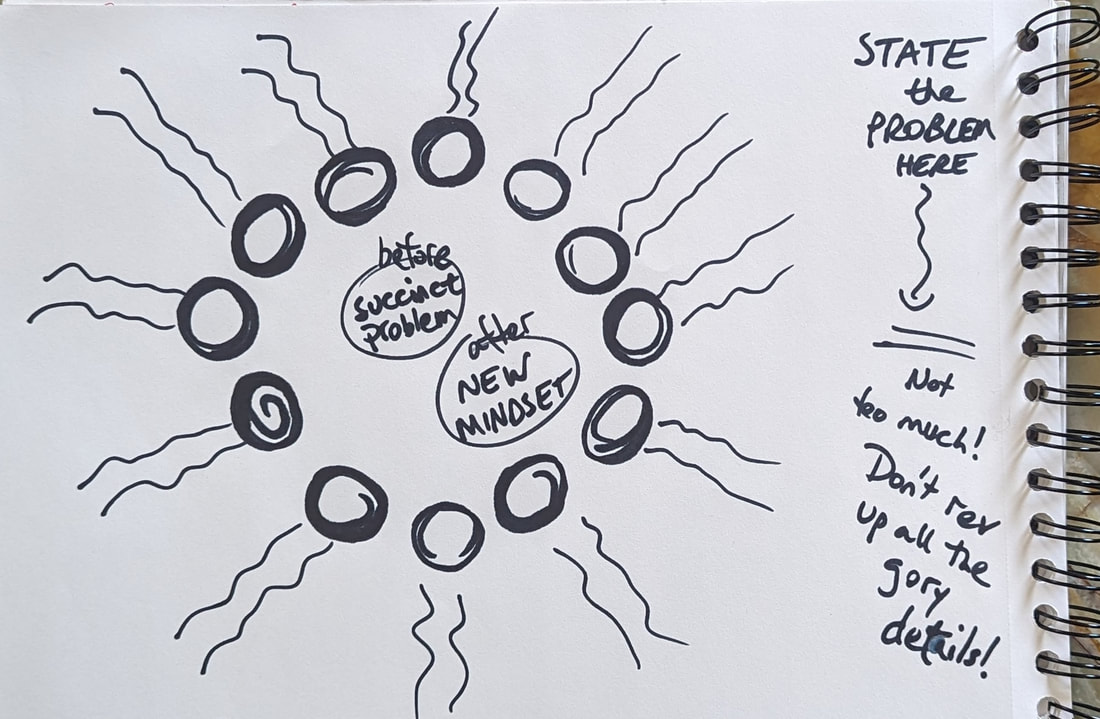|
... and let go of the hard & pointless work of being the doer Want a quicker read? You can simply learn or review the placemat process by starting below the first pic. Scroll down, baby … I was thinking about how hard it is for people to LET GO of trying to control all the parts and believing I’M THE ONE who makes it happen. Doership! We even stir up more confusion by accusing ourselves of being irresponsible or not properly showing up when we’re not doing our utmost (as we tense up & exhaust ourselves) to think of everything and manage all the parts. That’s a problem because
Those who use the G-word sometimes say, Let go and let God. Um, sure, that can be used to go complacent or excuse not stepping up. It can also be used to let go of what you can’t control, and let the greater intelligence do its thing. It will always include you in the doing (some of us think you are God and God is you), but won’t put you in charge of what you just don’t have the capacity to do, manage, or control (since you’re also in this limited ego-reality as an individual human being). When I first heard the term the organizing intelligence of the Universe, it just sang to me. I was already aware of the love force and fully down for that. I hadn’t thought about or even begun to take in (and that will be an ongoing process till I die) the unfathomable intricacies & crazy brilliance of what I now call the orchestration. So how do you come to know that, work with it better, FLOW with it, give yourself to that current? Play your part and put down what’s not yours? The PLACEMAT PROCESS from Abraham-Hicks is my favorite way to put stuff down and get crystal clear about what I’m doing and what I’m not doing. And bee-tee-dubs, it’s called that because Esther (yeah, the nice white lady from Texas who channels Abraham, which or who is actually a group of entities, I know, I know, but stay with me, please, because it’s brilliant)—Esther got this process while she was at a restaurant and used a paper placemat to try it out. For those who like Byron Katie’s 3 kinds of business, note that this allow you to clearly and on paper (where you won’t get sidetracked by all the slippery seaweed in the mind) write down in one area what belongs to the Universe and even to other people, and separately note what’s yours.
The act of writing it down is also a literal and symbolic putting it down. Placing it in those larger hands, or into that great holding net where everything’s being gorgeously woven together in a way that works for the good of all concerned. So in your area on the paper, you write down only what you’ll do today. Abraham says, Mean it. Whatever you put there, you know for sure you’ll get to it. Cool if you get this wrong, folks. Use it to take in how confused you still are about how much you’re supposed to and can get into a day. We’re actually not meant to CRAM OUR DAYS full with productive activity. Ay, that’s the great cultural lie of doership and what it means to be good little worker bees. (I imagine real bees are relaxed & having a good time as they bop around collecting pretty powdered nectar & turning it into exquisite golden honey.) But it’s not just that I’m NOT DOING the things I put down in the Universal Manager area. The organizing intelligence, or what A-H calls the Universal Manager, is all over it. Bringing things together with that uncanny right-place right-time precision, flowing things your way, getting people queued up to enter stage left or bump into you as you round the corner, in short—orchestrating. Or … lining up cooperative components that will support you to get to where you’re going. Do watch if you choose to experiment with this. Notice how things moved forward that you didn’t touch because you gave them, for real, to the UM who knows how to effortlessly make it all happen & come together gorgeously. So ANYTHING you’re thinking about, worried about, wishing you could get to, thinking you should already have gotten to (but truth is, you won’t get to it or can’t do anything about it today), PUT IT DOWN. You’ll know as you write (and after) you really are putting it and did put it down when you feel some RELIEF. When you relax. When you feel light instead of heavy. When you feel you’re doing enough, it’s good enough, all is well. (Notice the trust in this?) Put down all that you don’t need to carry today because it’s really not what’s up for YOU to manage, hold, do, or orchestrate. Examples:
When you can look at your little (way littler) list and feel good about THAT being the stuff of your activity today, you’re on the right track. Maybe you’ll even remember that the ACTUAL stuff of your day is not just what you check off the to-do list but …
Hey, I’ve heard Abraham gently & playfully scold people for acting like they’re delegating things to the Universal Manager, and then they have the right to be upset if something didn’t move something forward the way they’d hoped. You’re getting the benefits of the process when you feel RELIEF. Intend relief. Note relief means less resistance. It means you’re entering or you’re in the flow. It means you’ll give yourself a much easier time of it. There’s more going on too but … that’s enough, isn’t it? Love & blessings, Jaya
0 Comments
... and the amazing MARBLE GAME to use on this topic or any other Want a quicker read? Scroll down for a numbered list of 12 ways to think about time that feel better. If there’s any detrimental belief that A LOT of people from all walks of life share, at least in American culture and I daresay in most places around the globe, it’s that there’s not enough time. We have more to do that we have time to do it in. Does that even sound right? Is that even possible? And yet people walk around believing it. Please take a moment to notice the toll this takes on you. It’s going to do something that’s counter to total well-being. Any of this sound familiar?
And more. Any awareness hitting right about now about how absurd it is to give yourself this ongoing experience that’s based on an illusion? IT’S NOT REAL. But the effects of believing it are very real, and they impede so much:
And more. Abraham-Hicks has a clarifying and focusing process they call the marble game. It’s really simple and it’s really worth trying. Marbles are your thoughts and beliefs. All the thoughts and beliefs you’ve ever had. We have a lot of those, so in the marble game, you determine which ones you want ACTIVE in this situation. Which beliefs do you want to run the show? For example, you may have three marbles that say
You may have three other marbles that say
Which marbles would you like to have active as you look for a job or start the process of buying a house? Notice you’re likely to feel bad about yourself and ill-equipped for what’s next if you have the first three active; you’ll feel torn and vacillate between mindsets and the matching emotional states if you have all six active; you’ll feel empowered and curious about what’s possible with the last three active. So anytime in life that you notice you’re leading with a bad marble or you have a seriously active marble that’s not where you want to stand—like, There’s not enough time for all I need to get done—then play the marble game to consciously choose 12 marbles you want active. I did that on that very topic one morning recently. (See my activated, chosen marbles #1-12 below the illustration.) Use the right margin to lay out the problem. Draw a circle of 12 marbles (same positions as for numbers on the clock). In the middle of those, draw 2 circles. The first inner circle will contain the succinct version of the problem already written out in the margin: Not enough time for all tasks. Go ahead and put that in before you fill in beliefs next to each marble. Here, you could also just write a one-word statement of how you’re feeling about that margin problem (discouraged, depleted, angry). Write your 12 statements of more positive, empowering, helpful beliefs you already have (or ones you don’t have to reach too far to get to), the ones you do want to stand in and create from. These go next to the marbles where my squiggly lines are in the illustration. The second inner circle, you’ll fill in at the very end, when the writing out of 12 marbles you want activated brings you to a new mindset: Tasks & time coexist perfectly. (If you chose to write a single feeling word here as described above, then your new words might be brave, energized, accepting.) Here are the 12 marbles (things I actually believe, or that aren’t too far out of reach, and that I want to have as my ACTIVE beliefs) that got me from "Not enough time for all tasks" to "Tasks & time coexist perfectly."
I invite you to play with Abraham’s marble game to consciously activate the beliefs you want to live out of—or carry into just one situation that’s coming up. Love & blessings, Jaya |
Categories
All
|




 RSS Feed
RSS Feed